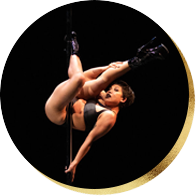Maximizing Your Prop Potential

Props can add a different dynamic to a routine. When they are best used, they can enhance the story you are telling on stage. However, when used poorly, they can be a distraction. Let's talk about how to seamlessly integrate your props into your performance.
Use It
If you have taken the time to identify a prop that works with your piece, commit to using it for more than a few seconds. When a prop is underused, it can confuse the judges and audience. Rather than being engulfed in your story, they are wondering if you are ever going to go back to it. Give your prop a purpose and use it with intention.
Bigger is Not Always Better
If your prop idea is larger than life, consider what is need to transport, store, assemble, and break down. You don't want your prop to be a burden on your fellow competitors (i.e. taking up prime real estate backstage). Having your moment on stage is the focus, minimize the stress of assembly and placement with size in mind.
Avoid Prop Photobombing
You have worked too hard on your routine for your prop to steal your moment. Steer clear of opportunities for your prop to hide your clean lines, cover up your face, or generally be in the wrong place at the wrong time.
Human Props
If you decide to invite your friend(s) to the stage as your human prop, a few things to consider. Give them choreography that adds value to the story you want to tell. Practice with them extensively to make sure they are in the right spots and the right time to not hinder your performance. And remember to still engage with the audience versus your sole focus being on the prop.
Practice for the Uht Ohs
What if your fan doesn't open? What if the bucket falls over? Although you can't plan for everything, walk through things that might go wrong. Mentally prepare for potential prop mishaps to be able to cover it up or make it less noticeable. Practice will set you up to not be freaked out or significantly jarred if a prop goes awry.
Check out one example of how to seamlessly integrate your prop: 2016 PSO Southwest Silver Medalist, Kirstie Ellerbe
Check out 2017 PSO Northwest Bea Morrow’s piece and her use of human props.
When considering prop or no prop, having a solid concept is step one. With a solid story foundation, identify a prop that adds a little sparkle. Give your prop a full purpose and use it with intention. And lastly, practice being prepared. Let us know if you have other prop potential tips to share.
About Pole Sport Organization

We believe that anyone, at any level, and any age should have a chance to be on stage. We are an inclusive event, meaning no submission videos, no prerequisites, and no required moves. Just sign up, and we'll see you at the show!
